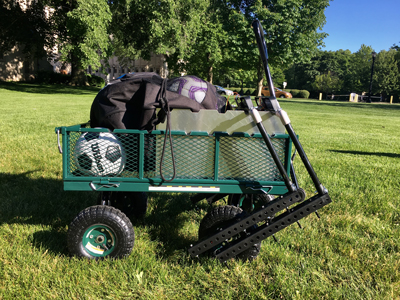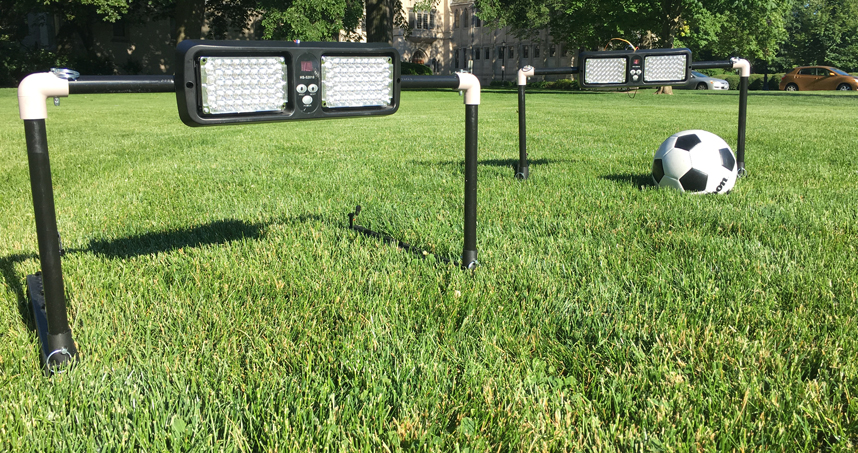A New Way to Practice Passing
Called Assists, the trainer offers a portable, inexpensive alternative to professional soccer facilities
In soccer, the ability to anticipate the arrival of teammates’ passes, receive the ball, and quickly and accurately redirect it is essential to executing a game plan. But it can be difficult for individual players to develop and measure these skills without multiple players to simulate game scenarios while training.
“It’s difficult to practice the unpredictable nature of passing and recreate think-on-the-fly situations without a full team,” said Rich Nassif, assistant coach for Northwestern’s men’s soccer team. “It is even more of a challenge to assess your performance by yourself. We can measure whether a pass reaches its intended target, but the ‘touch time’—how long it takes for the ball to be received and passed—is just as important.”
While professional soccer clubs in Europe have unveiled training facilities in recent years that use advanced technology and analytics to improve passing technique and touch time, the multi-million-dollar price tag and spatial footprint makes similar options unfeasible for most non-professional teams.
Now, thanks to an undergraduate student team in the Segal Design Institute’s Design 384: Interdisciplinary Design Projects course, a portable, cost-effective alternative may soon become a common part of training for Northwestern’s soccer program.
A mobile trainer at a fraction of the cost
The team collaborated with Nassif during the two-quarter course to design and prototype a passing trainer that players could easily set up and use on their own. Their solution, called Assists, provides analytical feedback about touch time and passing accuracy in non-practice settings. Costing under $500 to produce, the system combines four small soccer-style goals, LED lights, and an electronics system to create a 360-degree training environment at a fraction of the cost of professional trainers.

To operate Assists, a player stands in the middle of a circular arrangement of the goals, placed approximately 20 feet apart. The player then launches the iPhone app, which signals to an automatic ball feeder to send a ball to the player while simultaneously activating a red light on top of one goals, chosen at random. The player then receives the pass from the feeder, locates the lit goal, and kicks the ball through as quickly as they can.
After the drill ends, data on the number of scores and the time it took for the ball to pass through the target is sent from the goals to the app so players can assess their performance.
To develop a system that was portable enough to be packed and moved in a wagon while maintaining similar functionality to current professional training systems, group members Alex Friedman (’18), Emma Lane (’18), Aviv Delgadillo (’18), Connor Murray (’18), and Adam Muhammad (’17) used their interdisciplinary backgrounds in product design, mechanical engineering, electronics, and computer science to overcome design challenges.
“We considered several different shapes and materials for the goals, from sheet metal to cutting trashcans in half, so it fit like a half-circle tunnel,” said Friedman. “In the end, we decided a smaller version of a standard soccer goal made of PVC pipe was best because it allowed the ball to pass through from the most angles without knocking the goal out of position.”
While the team’s first-generation prototype requires a second player to pass to the trainee, the system’s electronics were designed to integrate within existing automated ball feeders.
“The group’s understanding of mechanical structure helped in designing goals that were portable, but stable, and their experience in computer science produced an electrical system that could be integrated into the hardware,” said John Lake, adjunct lecturer in the Segal Design Institute and the team’s adviser. “They learned how complicated a design project like this can get, but they leveraged their own experience to solve the serviceability challenges they faced.”
Making an immediate impact
In April, the team invited current Northwestern soccer players to test the efficacy of the Assists system. After overhearing teammates trade friendly barbs about their performances, the team felt confident that they had accomplished their goal.
“You could see the competition among the players come out during testing,” said Friedman. “They wanted to know their scores right away. It was exciting to see them get into the game and really enjoy the experience.”
Nassif hopes to make Assists available to players during the team’s summer off-season, a time when there are limits on organized team activities. He believes the competitive culture within Northwestern’s soccer program will make the trainer a popular tool for skill development.
“The trainer shows our players that just because our coaches can’t go out there and pass with you doesn’t mean you can’t still train,” said Nassif. “Our players are not only competitive, but they are also analytical. We think Assists can become a valuable tool to improve their game and provide very concrete and definitive results about how they are getting better.”

